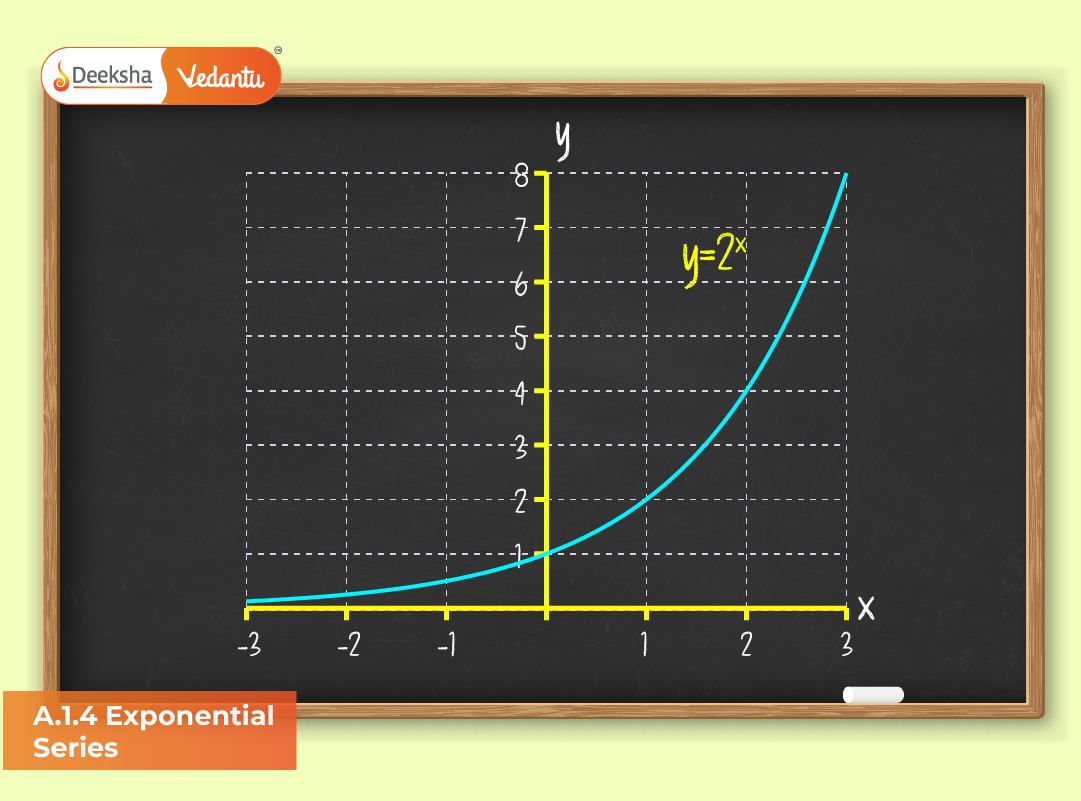
Overview
The Exponential Series is a crucial mathematical concept connecting algebra, calculus, and exponential functions. It is frequently tested in JEE Main and JEE Advanced, forming the base for understanding exponential growth, differential equations, and limits. This series helps express exponential functions as infinite sums, allowing precise approximations in both pure and applied mathematics.
The exponential function is defined as e⁽ˣ⁾ = 1 + x + x²/2! + x³/3! + x⁴/4! + … ∞. This representation is known as the Maclaurin series expansion for e⁽ˣ⁾.
Historical Background
The concept of an exponential series dates back to the 17th century, when mathematicians like Isaac Newton and James Gregory developed series expansions for common functions. Later, Euler formalized the exponential constant e, which is approximately 2.71828, as the base of natural logarithms. Today, this series plays a major role in solving growth models, calculating compound interest, and analyzing functions in calculus.
Definition
For any real or complex number x:
e⁽ˣ⁾ = 1 + x/1! + x²/2! + x³/3! + x⁴/4! + …
This is an infinite series, where each term is of the form xⁿ/n!. The series converges for all values of x, making it universally valid — a property not shared by all power series.
Convergence of Exponential Series
The ratio test proves that the exponential series converges absolutely for all finite values of x:
lim (n→∞) (a₍ₙ₊₁₎/aₙ) = lim (n→∞) (x⁽ⁿ⁺¹⁾/(n+1)!)/(xⁿ/n!) = lim (n→∞) (x/(n+1)) = 0
Since the limit is less than 1, the series converges for all x ∈ R.
Properties of Exponential Series
- Infinite Convergence: The series converges for all real x.
- Differentiability: Every term of the series is differentiable, and differentiation term-by-term reproduces the same series.
- Exponential Law: e⁽ˣ⁺ʸ⁾ = e⁽ˣ⁾ × e⁽ʸ⁾
- Inverse Function: The inverse of e⁽ˣ⁾ is ln(x), which is also represented by a power series.
- Symmetry: For negative x, e⁽⁻ˣ⁾ = 1/e⁽ˣ⁾.
Proof of the Series Representation
From calculus, the derivative of e⁽ˣ⁾ equals itself:
d/dx (e⁽ˣ⁾) = e⁽ˣ⁾
If we expand e⁽ˣ⁾ as a power series e⁽ˣ⁾ = Σ aₙxⁿ, then differentiating gives:
e⁽ˣ⁾ = a₁ + 2a₂x + 3a₃x² + …
Equating coefficients yields aₙ = 1/n!, proving:
e⁽ˣ⁾ = 1 + x + x²/2! + x³/3! + …
Important Special Cases
- e⁰ = 1
- e¹ = e = 2.71828…
- e⁽⁻ˣ⁾ = 1 – x + x²/2! – x³/3! + …
- e⁽ⁱˣ⁾ = cos(x) + i sin(x) (Euler’s formula)
Comparison of Exponential Series with Other Series
| Function | Series Expansion | Domain of Convergence |
| e⁽ˣ⁾ | 1 + x + x²/2! + x³/3! + … | All x |
| sin(x) | x – x³/3! + x⁵/5! – … | All x |
| cos(x) | 1 – x²/2! + x⁴/4! – … | All x |
Applications in JEE
- Approximation Problems: Estimating exponential values like e² or e⁻¹.
- Differential Equations: Solutions to dy/dx = y.
- Limits: Evaluating expressions like (1 + 1/n)ⁿ.
- Integration & Series: Simplifying power series for advanced calculus.
Marks Weightage
| Exam | Topic | Average Weightage | Difficulty Level |
| JEE Main | Series Expansion | 4 Marks | Moderate |
| JEE Advanced | Exponential & Logarithmic Series | 4–8 Marks | Moderate to Difficult |
Sample JEE Problems
Problem 1:
Expand e² up to four terms.
Solution:
e² = 1 + 2 + 2²/2! + 2³/3! = 1 + 2 + 2 + 1.333 = 6.333
Problem 2:
Show that e⁽ˣ⁾ × e⁽⁻ˣ⁾ = 1.
Solution:
Using the expansions:
e⁽ˣ⁾ = 1 + x + x²/2! + x³/3! + …
e⁽⁻ˣ⁾ = 1 – x + x²/2! – x³/3! + …
Multiplying term by term, all intermediate terms cancel, leaving only 1.
Problem 3:
If e⁽ˣ⁾ = 1 + x + x²/2 + x³/6 + …, find d/dx(e⁽ˣ⁾) at x = 0.
Solution:
d/dx(e⁽ˣ⁾) = e⁽ˣ⁾; thus, at x = 0, e⁰ = 1.
Problem 4 (Advanced):
Show that lim (n→∞) (1 + x/n)ⁿ = e⁽ˣ⁾.
Solution:
By definition of e, the limit expands to the infinite exponential series.
Real-World Applications
- Physics: Radioactive decay, capacitor discharge.
- Biology: Population growth and bacterial multiplication.
- Economics: Compound interest and inflation models.
- Engineering: Exponential response in circuits and heat transfer.
Relationship with Logarithmic and Trigonometric Series
- e⁽ˣ⁾ is the parent of logarithmic and trigonometric series through Euler’s identity.
- It forms a bridge between exponential growth and oscillatory motion.
FAQs
Q1. What is the exponential series formula?
It is e⁽ˣ⁾ = 1 + x + x²/2! + x³/3! + … ∞.
Q2. Does the exponential series converge for all values of x?
Yes, it converges absolutely for all x ∈ R or C.
Q3. How is this concept used in JEE exams?
Questions involve approximations, expansions, or applying the exponential series in calculus-based problems.
Q4. What is the relation between exponential and trigonometric series?
Euler’s relation connects them: e⁽ⁱˣ⁾ = cos(x) + i sin(x).
Q5. How to quickly approximate e⁽ˣ⁾ in exams?
Use first three to four terms for accurate results: e⁽ˣ⁾ ≈ 1 + x + x²/2! + x³/3!.
Conclusion
The Exponential Series is one of the most fundamental and versatile mathematical tools. Its convergence for all real numbers and direct relation to calculus make it indispensable for JEE aspirants. Understanding its properties, derivations, and applications helps solve diverse problems — from simple algebraic expansions to complex differential equations. A strong grip on this topic ensures success not only in JEE Main & Advanced but also in higher-level mathematics and engineering problem-solving.






Get Social